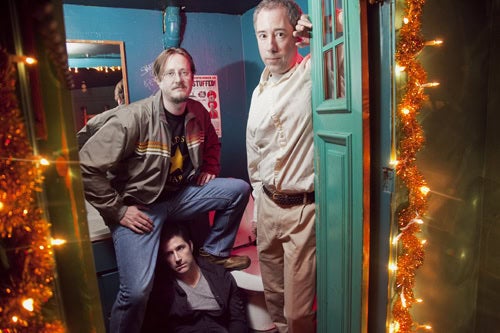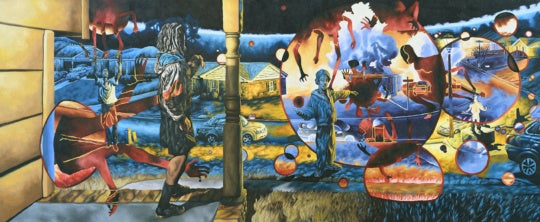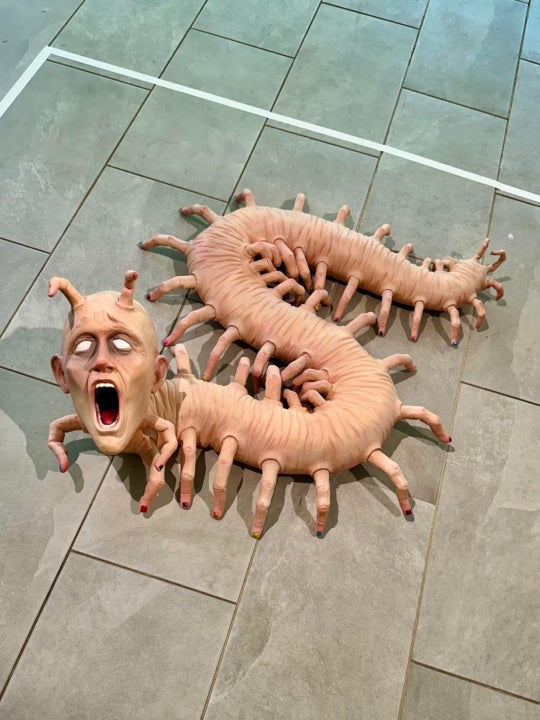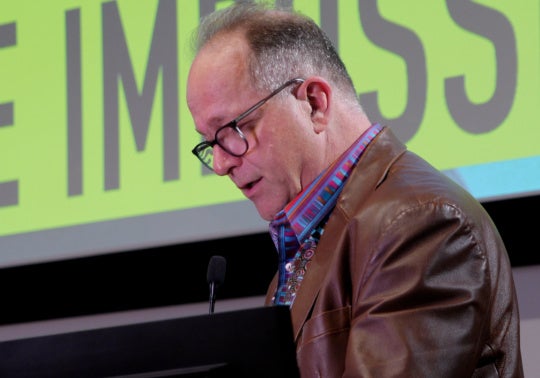
After just over a year since they started working together, the Atlanta-based collective John Q quickly established themselves as one of the year’s top artistic power-teams. Curator Joey Orr, archivist Wesley Chenault, and musician and film-buff Andy Ditzler debuted their combined exploration of Atlanta’s queer history in a series of public-space interventions entitled Memory Flash in April of 2010. Elements of these happenings, including objects and sound and video documentation, are currently on display in an experiential catalogue called Discursive Documents at the Museum of Contemporary Art of Georgia (MOCA GA) through January 8, 2011. We sat down with the members of John Q at Mixx, the bar the collective chose as the final location visited during Memory Flash, to talk about their work.
BURNAWAY: The first official John Q project, Memory Flash, was in April, but how long have you been a collective?
Joey Orr: Just a little over a year, officially. We came together at the same time Flux Projects was organizing.
Wesley Chenault: Yes, Joey started conversations with each of us. Joey is the cement. He brought us together, and I think by November, 2009, we were having conversations.
JO: By November, we had deadlines!
Andy Ditzler: We can act quickly. A lot of this can be blamed on Joey.
Joey, what made you pick Wesley and Andy as your two collaborators?
JO: It’s like my mission for world peace: I picked the people I cared for the very least, and then I had to come to terms with them. [Laughs.] Actually, [the choice] was already done by the universe; I just noticed it first.
Wesley did a big project at the Atlanta History Center [called] The Unspoken Past: Atlanta Lesbian and Gay History. That was a social history project about gays and lesbians in Atlanta prior to the Civil Rights movement. I worked with Wesley on the project as curator of oral history.
WC: Joey and I knew each other years before in a social context, so it was very interesting coming together [for this]. I met Andy [while working] in my role as an archivist, because he came to the Atlanta History Center to research old home movies for a project he was curating for Atlanta Celebrates Photography.
JO: When I came back to Atlanta a little over a year ago, I wanted to [revisit] the public installations I had done [before], where I had always been in the role of curator, [but] this time I wanted to be more hands-on and actually generate the work. I found out Andy was interested in restaging a film screening that had been shut down at Ansley Mall, and that was exactly the kind of work I was interested in doing. It was time to get all of us in the same room.
Your collective’s name originated from the idea of “John Q. Public,” but dropping the “Public” to emphasize the “Q” for queer. How did you decide on the name?
WC: It was at Andy’s house.
JO: What else were we thinking about naming ourselves?
WC: Electric Bugalooo, Flux, Reflux …. [Laughs.]
JO: We were going to be Flux Projects, but it was taken, damn it!
AD: Reflux was my favorite.
WC: Fluxus, Dada ….
JO: That was fun actually. When we met with Anne [Dennington] and Louis [Corrigan of Flux Projects] about our first project, they didn’t have a name, either. We were both brainstorming.
Are you all originally from Atlanta?
JO: I’m a native.
WC: Decatur, Alabama—an armpit and an asshole near Huntsville, Alabama. I went to Auburn University, and my circle of friends all came to Atlanta after graduation.
AD: I come from a state called Indiana, from the far reaches, a small part in northern Indiana. I went to Indiana University and studied music as a percussionist, and now I’m in John Q.
JO: Anybody who sees Andy in the State of Indiana is allowed to shoot him in the ass. [Laughs.]
The South has a strong sense of history, and many Southerners are interested in their genealogies. Does this sense of place have any bearing on your interest in history?
JO: This is a big question.
AD: Do you have to link between being queer and being interested in history?
JO: I don’t know if my interest in history has to do with place or not. What I’m interested in is how memory becomes history with a capital “H.” The reason I’m interested in that question is, if you know you can actually participate [in the creation of history, it becomes possible to say:] “I want to be a subject of history, not an object of history.” That’s where the intervention stuff comes in.
AD: There’s the whole film aspect of this. You have a history of everyday life that can be well documented [in film], but we don’t know who was queer and who wasn’t. A lot was destroyed. A lot of what remains is the transgressive stuff, whether it’s Warhol, Ginsberg, and so on. But there’s a vanishing society that was not as transgressive on the political inside. You need both of those things. That’s how Lonesome Cowboys came into it. It was that other side of things. When we talk about queer history that’s where I’m coming from.
WC: The police records are there—codified. They’re there. You could go through Georgia Bureau of Investigation’s vice records. But how do you take those records and make subjects become objects? We’re dealing with the realities of individuals who were self-possessed and who were very cognizant of what they were doing. You can’t look at silence as absence; you have to look at it as something empowering.
JO: We engage in visual art production as a way of thinking about who we are and what we do. So now what’s happening is that, with things like visual studies, cultural studies, and studio PhD programs, there’s a whole other intellectual layer being laid on top of what visual art can do. I think of Memory Flash as an intellectual endeavor. I’ve spent much more time and research and money on this project than I have on papers or articles or presentations. It is much more demanding. For me, it’s a comment on the rigor and legitimacy of visual art production.
Do you think that Atlanta specifically is important to this project?
JO: As a native to Atlanta, I think the whole idea of forgetting is paramount to the history of Atlanta. We didn’t control how [Memory Flash] was received, or how it was proliferated. It wasn’t just, “Let’s let everybody know about Atlanta’s queer history.” It was, “What do we think about memory? What if we create new memories? Where will they go?”
WC: It’s a city that has destroyed itself continuously in the name of modernization. The city is built on the narrative of Sherman’s destruction, but, at its own hands, it continues to tear itself down. It’s traumatizing that Sherman did it, but never that Atlanta does it [to itself].
JO: There’s a great FDR quote that’s something like, “Atlanta would be a great city, if they’d ever stop building it.”
You use the word “interventions” to describe your projects. Why that word?
WC: It’s an intervention to [prevent] forgetting. It’s a way to deal with the forgetting that happens.
JO: In one manner of speaking, it’s a way to categorize the work that we do, to put it into an intelligible category or [to frame it in terms of] Situationist theory. The kinds of things we were doing weren’t happening naturally, so there was a disruption of the rhythm and flow of those places for a minute. The idea of intervening is like crossing against a grain for just a second, so it becomes noteworthy.
Susannah Darrow: I grew up in Atlanta, but I was blown away by how I didn’t know about any of this part of its history.
AD: We didn’t either!
WC: There’s no narrative of it [or] book you go to, and it’s certainly not part of the urban Atlanta history. Much of this is day-to-day stuff, and how much do we know about anyone’s day-to-day life? Freddie Styles had a group called the Jolly 12—how would you know that unless you were in his group of friends or were a witness to that call-and-response interaction?
AD: When Wesley says call-and-response, [he refers to the time when] Roger Hodges was the leader of this group, and they would march down the street. People would sit out on their porches, the Jolly 12 goes marching by, and somebody yells from over their porch, “Hey, Mother Hodges.” And he says without missing a beat, “Hey, Motherfucker,” and they keep walking. That’s the story [from] the oral history that kind of got this started.
Are there any contemporary theorists that you have been looking to?
JO: Nicholas Mirzoeff is a really interesting visual culture theorist and is best known for the Visual Culture Reader. Mirzoeff’s current project on media is about the new everyday. I really identify with that given John Q’s project.
So Memory Flash is about these more quotidian level events, not a major Stonewall epic.
AD: It’s what’s attractive about it.
JO: This intervention in everyday life is extremely important. The student revolutions in the late 60s were a way for the student class to align with the working class. Memory Flash is about queer history, but it does not have an exclusively queer audience. Several years ago, there were a couple of projects by Benita Carr organized by Susan Bridges that took place on the lot at Krog Street and Dekalb Avenue. It was a photographic show inside a truck. Every time I drive past that corner, I remember it. A few years later, she did a project at the water tower on Irwin Street that turned a bedspring into an instrument. Every time I drive by those places, I remember the art.
What are your spirit animals?
JO: The ugly doll.
AD: A pack of wolves. But it morphs … so other times it might be other single animals.
WC: A wolverine.
John Q: The barfly that ate the bookworm




